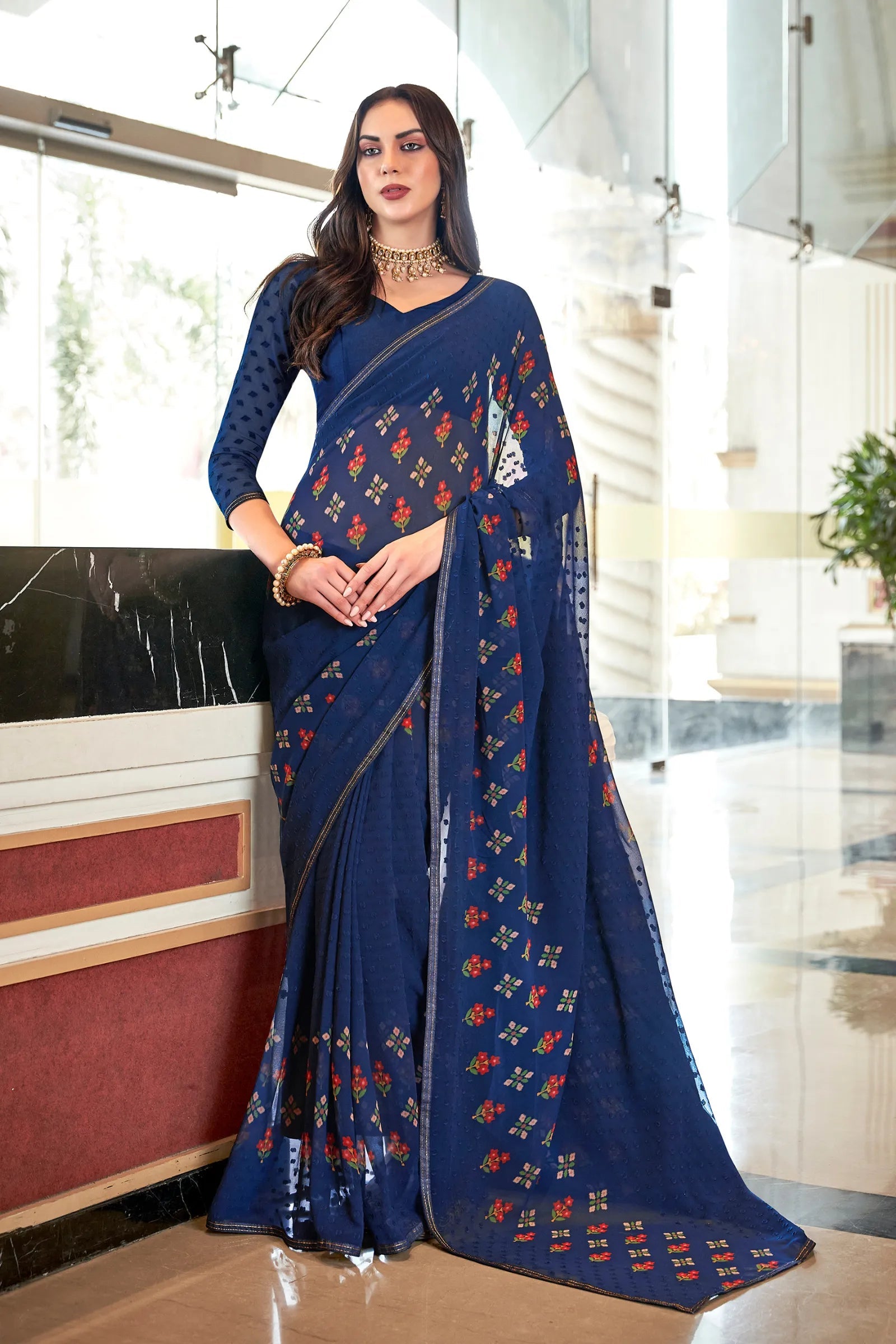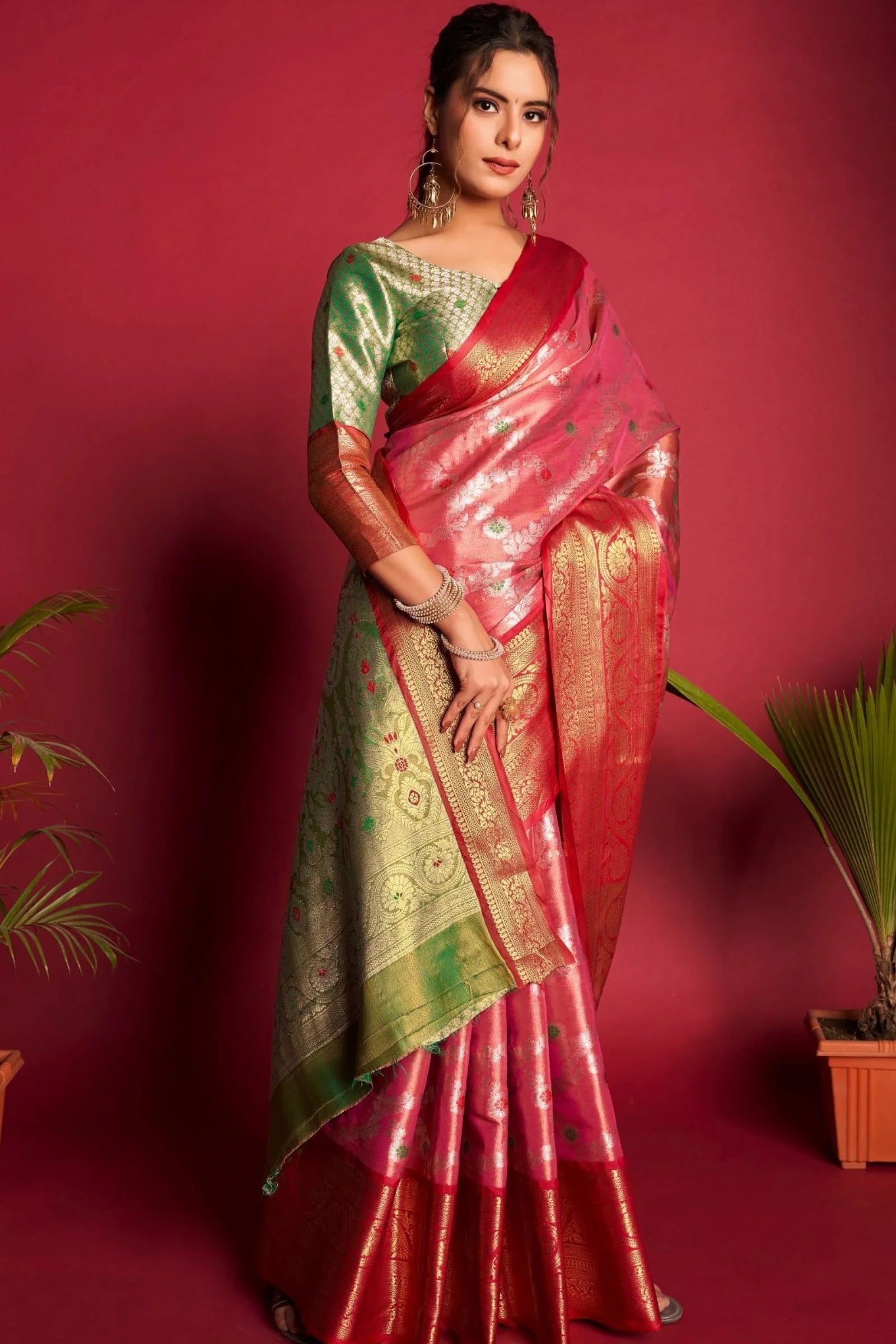The Kalamkari method of hand painting cotton or silk fabrics is a traditional method of hand painting using natural dyes and a tamarind pen. As the name implies, Kalamkari derives from a Persian word where the word 'kalam' indicates pen and the word 'kari' means craftsmanship. This craft requires 23 laborious steps, including starching, cleaning, hand painting, block printing, dyeing, bleaching, and more. Flowers, peacocks, paisleys, and divine figures from Hindu epics such as the Mahabharata and Ramayana are just a few of the motifs used in Kalamkari artwork. Nowadays, this art is primarily done to create Kalamkari sarees.
A large number of families in Andhra Pradesh and some villages in Tamil Nadu have practiced Kalamkari art as a source of livelihood over the generations. The wealthy middle ages saw the peak of its popularity as an art form. During the Mughal rule of the Coromandel, this craft was called qualamkari by the Mughals, which evolved into the term kalamkari. During this period, cotton fabrics patterned with geometric patterns were made.
Freehand painting and block printing of vegetable dyes are used. When block printing is used, the kalam (pen) is used to draw finer details and apply some colors. This is entirely digital in the modern era. New varieties and new methods are developed, and digital files of kalamkari (pen work) are completely distributed throughout all India.
Techniques Used In Manufacturing of Kalamkari

There are 23 steps in the making of kalamkari. The entire process, from the natural bleaching, softening, sun drying, preparing of natural dyes, hand painting, air drying, and washing of the fabric, requires accuracy and attention to detail. A mixture of cow dung and bleach is first used to treat cotton fabric used for Kalamkari. After hours of soaking in this solution, the fabric turns a consistent off-white color. The cotton material is then submerged in a solution of buffalo milk and Myrobalans.
If natural dyes are used to paint the fabric, this prevents dye smudging. The fabric is later washed in running water to get rid of the buffalo milk smell. The fabric is similarly washed twenty times and then dried outside. The fabric is sketched with motifs and designs by artists once it is ready for painting. Then, to add color to the drawings, the Kalamkari artists make dyes from natural sources.
The Kalamkars use a tamarind twig as a pen to draw intricate designs of Krishna Raas-Leela, Hindu deities like Parvati, Vishnu, and Shri Jagannath, as well as peacock and lotus motifs and scenes from Hindu epics like the Mahabharata and Ramayana.
Types of Kalamkari
In India, there are two distinguishable Kalamkari art styles: Machilipatnam style and Srikalahasti style. In the Machilipatnam style of kalamkari, the intricately detailed motifs are primarily printed using hand-carved traditional blocks. In contrast, the Srikalahasti style of painting is influenced by Hindu mythology and depicts scenes from epics and folklore. Because it originated in temples, this fashion has a strong religious undertone.
According to the states where it is produced, two additional categories of Kalamkari patterns have also recently appeared. Two of India's most important states, Gujarat and Andhra Pradesh, are where two different kinds of Kalamkari patterns are created. The Andhra Kalamkari incorporates animal and bird motifs as well as architectural elements from Indian forts, palaces, and temples. While mythological figures like Krishna and Arjuna from the Mahabharata, Lord Krishna, Lord Ganesh, Lord Buddha, etc. are depicted in Gujarat Kalamkari.
Colors Used in Kalamkari
Earthy colors like indigo, mustard, rust, black, and green are frequently used in kalamkari art. Natural sources are used to extract the dyes, which are then used to create the colors in Kalamkari artwork without the use of chemicals or artificial materials. For instance, artisans create black color by mixing iron fillings, water, and jaggery, which they primarily use to outline sketches. Pomegranate peels can be used to make mustard or yellow dyes by boiling them, but madder or algarin bark can be used to make red dyes. The same is true for blue, which comes from indigo, and green, which is created by combining yellow and blue.
Fabrics for Kalamkari

One of India's traditional arts, kalamkari is renowned for its extraordinarily exquisite hand paintings on textiles. This is a very common handspring used in fabrics for clothing such as sarees, ready-to-wear salwar kameez, kurtas, etc. The most prevalent theme is depicting magnificent paintings of sun chariots, well-known deities, and scenes from the Ramayana and Mahabharata epics.
The exquisite craftsmanship of Indian artists is displayed in kalamkari sarees. It is the ideal fusion of style and tradition, followed by contemporary trends. A large selection of Kalamkari sarees is available in various styles and fabrics. Due to the use of natural dyes and colors, they do not fade when washed.
For women seeking style and refinement, kalamkari sarees are ideal. The Kalamkari prints add a distinctive style to both cotton and silk sarees. Block-printed sarees made of kalamkari silk are comfortable and easy to wear. Make sure to dry wash or use petrol wash for better results because regular hand washing can cause the fabric to shrink.
The Kalamkari designs bring out the best in you. Even though they are traditional sarees, they continue to hold value in the current fashion industry. The fabric has a rich appearance due to the combination of Kalamkari's artwork.
Kalamkari sarees which are popularly preferred by women, come in Cotton, Georgette, Designer wear, silk sarees, printed Sarees, and Chanderi to accentuate authentic traditional craftsmanship.
Modern Pick for Kalamkari Sarees
Kalamkari art has come a long way from its earliest depictions as religious paintings of Indian gods and goddesses, to its process of becoming well-known during the Mughal dynasty's rule, and up to the present day, when Andhra Pradesh is the largest producer of Kalamkari.
Due to the laborious process required to create it in the previous ten years, Kalamkari art was beginning to lose its luster. The process of this art's extinction was accelerated by the introduction of highly advanced machine looms and printed textiles.
However, it was Indian fashion designers who banded together to help artisans in the state of Andhra Pradesh who were practicing this art. Kalamkari sarees were once again prominently displayed on the fashion runways because of some creative minds behind this impeccable technique.
Iraah’s Tremendous Kalamkari Sarees

Iraah has always been a brand that supports India's handcrafted and handwoven traditions. One hand-printed textile style we have long admired and supported is kalamkari. The Kalamkari saree stands out from other sarees because of its luxurious appearance. Despite being a traditional saree, it has found favor in the contemporary fashion world.

